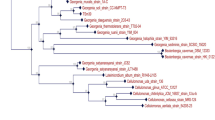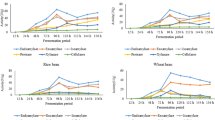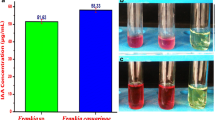Abstract
Background, aim, and scope
The focus of the present study is to know the potential of bacterial isolate for tannic acid degradation at low temperature. Also, we tried to evaluate the suitability of phytotoxicity testing protocol for the determination of tannic acid toxicity.
Methods
Screening for tannic acid degrading bacterial strains was carried out by using microbial isolation techniques. The 16S rDNA amplicon of the isolate was used to identify the isolate. The effect of different concentrations of tannic acid and its degradation products on germination of Vigna unguiculata was evaluated. The study was carried out to determine total sugar and starch content of the used seeds and even to check the presence of α-amylase activity during seed germination.
Results
The isolated bacterium was identified as Klebsiella sp NACASA1 and it showed degradation of tannic acid in 40 (±0.85***) h at 15°C and pH 7.0. A gradual decrease in root/shoot length was observed with increasing concentration of tannic acid. There was 95.11 (±0.24**)% inhibition in α-amylase activity at 20,000 ppm tannic acid, as compared to control. No such effects were observed on germination, root–shoot length, and α-amylase activity with tannic acid degradation products.
Conclusions
The results obtained confirmed that tannic acid may act as a toxic agent in plant cells. The simple biodegradation process presented in this study was found to be effective in reducing toxicity of tannic acid. Also, it reveals the potential of soil bacterium to degrade tannic acid at low temperature.







Similar content being viewed by others
References
Archambault J, Lacki K, Duvnjak Z (1996) Conversion of catechin and tannic acid by an enzyme preparation from Trametes versicolor. Biotechnol Lett 18:771–774
Basaraba J (1966) Effects of vegetable tannins on glucose oxidation by various microorganisms. Can J Microbiol 12:787–794
Beck E, Ziegler P (1989) Biosynthesis and degradation of starch in higher plants. Annu Rev Plant Physiol Plant Mol Biol 40:95–117
Bhakta Dipita and Ganjewala Deepak (2009) Effect of Leaf Positions on Total Phenolics, Flavonoids and Proantho-cyanidins Content and Antioxidant Activities in Lantana Camara (L) J. Sci. Res. 1 (2),363-369
Bhat T, Singh B, Sharma O (1998) Microbial degradation of tannins—a current perspective. Biodegradation 9:343–357
Chiacchierini E, Restuccia D, Vinci G (2004) Bioremediation of food industry effluents: recent applications of free and immobilised polyphenoloxidases. Food Sci Technol Int 10:373–382
Colpas F, Ono E, Rodrigues J, Passos J (2003) Effects of some phenolic compounds on soybean seed germination and on seed-borne fungi. Braz Arch Biol Technol 46:155–161
Deschamps A, Mahoudeau G, Conti M, Lebeault J (1980) Bacteria degrading tannic acid and related compounds. J Ferment Technol 58:93–97
Deschamps A, Otuk G, Lebeault J (1983) Production of tannase and degradation of chestnut tannins by bacteria. J Ferment Technol 61:55–59
Dubios M, Gilles J, Robers P, Smith F (1951) Colorimetric determination of sugar and related substances. Anal Chem 26:351–356
Felsenstein J (1985) Confidence limits on phylogenies: an approach using the bootstrap. Evolution 39:783–791
Field J, Lettinga G (1992) Biodegradation of tannins. In: Sigel H (ed) Metal ions in biological systems volume 28. Degradation of environmental pollutants by microorganisms and their metalloenzymes. Marcel Dekker, New York, pp 61–97
Fincher G (1989) Molecular and cellular biology associated with endosperm mobilization in germinating cereal grains. Annu Rev Plant Physiol Plant Mol Biol 40:305–345
Franco A, Calheiros C, Pacheco C, De-Marco P, Manaia C, Castro P (2005) Isolation and characterization of polymeric galloyl-ester-degrading bacteria from a tannery discharge place. Microb Ecol 50:550–556
Fuchs G, Mohamed M, Altenschmidt U, Koch J, Lack A, Brackmann R, Lochmeyer C, Oswald B (1994) Biochemistry of anaerobic biodegradation of aromatic compounds. In: Ratledge C (ed) Biochemistry of microbial degradation. Kluwer, Dordrecht
Gandhi P (1990) Microbial degradation with special reference to tannery. Doctoral thesis, Madurai Kamaraj University, Madurai, India
Garg S, Makkar H, Nagal K, Sharma S, Wadhwa D, Singh B (1992) Toxicological investigations into oak (Quercus incana) leaf poisoning in cattle. Vet Hum Toxicol 34:161–164
Geerdink M, Loosdrecht M, Luyben K (1996) Biodegradability of diesel oil. Biodegradation 7:73–81
Gu L, Kelm M, Hammerstone J, Beecher G, Holden J, Haytowitz D, Prior R (2003) Screening of foods containing proanthocyanidins and their structural characterization using LC-MS/MS and thiolytic degradation. J Agric Food Chem 51:7513–7521
Gubler F, Kalla R, Roberts J, Jacobsen J (1995) Gibberellin-regulated expression of a myb gene in barley aleurone cells: evidence for Myb transactivation of a high-pI alpha-amylase gene promoter. Plant Cell 7:1879–1891
Haslam E (1966) The scope of vegetable tannin chemistry. Chemistry of vegetable tannins. Academic, London, pp 1–13
Ilori M, Adebusoye S, Amund O, Oyetoran B (2007) A study of tannic acid degradation by soil bacteria. Pak J Biol Sci 10:3224–3227
Kapanen A, Itavaara M (2001) Ecotoxicity tests for compost applications. Ecotoxicol Environ Saf 49:1–16
Lee C, Russell N, White G (1995) Rapid screening for bacterial phenotypes capable of biodegrading anionic surfactants: development and validation of a microtitre plate method. Microbiol 141:2801–2810
Lekha P, Lonsane B (1997) Production and application of tannin acyl hydrolase: state of the art. Adv Appl Microbiol 44:215–260
Lowry O, Rosebrough N, Farr A, Randall R (1951) Protein measurement with the Folin phenol reagent. J Biol Chem 193:265–275
Marchesi J, White G, Russell N, House W (1997) Effect of river sediment on the biodegradation kinetics of surfactant and non-surfactant compounds. FEMS Microbiol Ecol 23:55–63
Margesin R, Schinner F (1998) Low-temperature bioremediation of a waste water contaminated with anionic surfactant and fuel oil. Appl Microbiol Biotechnol 49:482–486
Margesin R, Schinner F (1999) Biodegradation of organic pollutants at low temperatures. In: Margesin R, Schinner F (eds) Biotechnological applications of cold-adapted organisms. Springer, Berlin, pp 271–289
McCready R, Guggolz J, Silviera V, Owens H (1950) Determination of starch and amylase in vegetables. Anal Chem 22:1156–1158
Mingshu L, Kai Y, Qiang H, Dongying J (2006) Biodegradation of gallotanins and ellagitannins. J Basic Microbiol 46:68–84
Monier J, Lindow S (2005) Aggregates of resident bacteria facilitate survival of immigrant bacteria on leaf surfaces. Microb Ecol 49:343–352
Moreland D, Novitzky W (1987) Effects of phenolic acids, coumarins, and flavonoids on isolated chloroplasts and mitochondria. In: Waller GR (ed) Allelochemicals: role in agriculture and forestry. American Chemical Society, Washington, pp 247–261
Saitou N, Nei M (1987) The neighbor-joining method: a new method for reconstructing phylogenetic trees. Mol Biol Evol 4:406–425
Scalbert A (1991) Antimicrobial properties of tannins. Phytochem 30:3875–3883
Sengupta S, Jana M, Sengupta D, Naskar A (2000) A note on the estimation of microbial glycosidase activities by dinitrosalicylic acid reagent. Appl Microbiol Biotechnol 53:732–735
Somasegaram P, Hoben H (1985) Methods in legume Rhizobium technology. NifTAL, Paia Maui
Tamura K, Nei M, Kumar S (2004) Prospects for inferring very large phylogenies by using the neighbor-joining method. Proc Natl Acad Sci USA 101:11030–11035
Tamura K, Dudley J, Nei M, Kumar S (2007) MEGA4: molecular evolutionary genetics analysis (MEGA) software version 4.0. Mol Biol Evol 24:1596–1599
Timmis K, Pieper D (1999) Bacteria designed for bioremediation. Trends Biotechnol 17:201–204
Tiquia S (2010) Reduction of compost phytotoxicity during the process of decomposition. Chemosphere 79:506–512
Yamamoto Y, Fujii Y (1997) Exudation of allelopathic compound from plant roots of sweet vernalgrass (Anthoxanthum odoratum). J Weed Sci Technol 42:31–35
Zucconi F, Forte M, Monaco A, De-Bertoldi M (1981a) Biological evaluation of compost maturity. BioCycle 22:27–29
Zucconi F, Pera A, Forte M, De-Bertoldi M (1981b) Evaluating toxicity of immature compost. BioCycle 22:54–57
Author information
Authors and Affiliations
Corresponding author
Additional information
Responsible editor: Elena Maestri
Rights and permissions
About this article
Cite this article
Jadhav, U., Kadu, S., Thokal, N. et al. Degradation of tannic acid by cold-adapted Klebsiella sp NACASA1 and phytotoxicity assessment of tannic acid and its degradation products. Environ Sci Pollut Res 18, 1129–1138 (2011). https://doi.org/10.1007/s11356-011-0468-6
Received:
Accepted:
Published:
Issue Date:
DOI: https://doi.org/10.1007/s11356-011-0468-6




